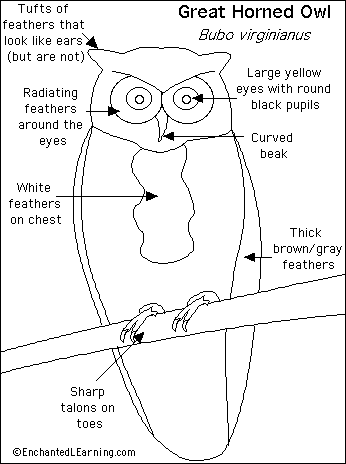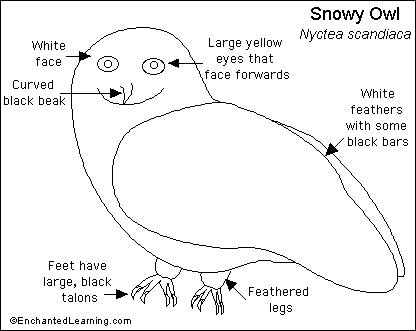 |
 |
Reply
 | |
 The Great Horned Owl is the largest owl in North America. It is sometimes called the cat owl. This widespread bird of prey lives in mountains, grasslands, conifer forests, deserts, chapparals, and many other habitats in North and South America. Its scientific name is Bubo virginianus (Genus and species). Its call is a far-carrying hoot. The Great Horned Owl is the largest owl in North America. It is sometimes called the cat owl. This widespread bird of prey lives in mountains, grasslands, conifer forests, deserts, chapparals, and many other habitats in North and South America. Its scientific name is Bubo virginianus (Genus and species). Its call is a far-carrying hoot. Anatomy: This owl is 18 to 25 inches (46-64 cm) long and has a wing span of 52 to 55 inches (1.3-1.4 m); its weight averages about 3 pounds (1.5 kg). The feathers of the Horned Owl are gray to brown to buff to black. There is a patch of white feathers on the brown chest (called a "gular"). The eyes are yellow with round black pupils. Large tufts of feathers on its head give this owl its name; they are neither ears nor horns, they are just feathers. Diet: Owls are carnivores (meat-eaters). The Great Horned Owl is mostly nocturnal (most active at night). Owls use a keen sense of sight to find prey in the dark (they see mostly in black and white). They also have an acute sense of hearing which helps in finding meals. Owls are stealth hunters; they can easily sneak up on their prey since their fluffy feathers give them almost silent flight. The Great Horned Owl hunts and eats mammals (like rabbits, skunks, woodchucks, mice, rats, and squirrels), birds (ducks, quail, and geese), and fish. The owl is at the top of the food web; it has no major predators. It sometimes eats its prey whole and later regurgitates the bones, fur, and feathers in pellets. Nest and Eggs: Great Horned Owls usually use abandoned hawk or heron nests. In each clutch (a set of eggs laid at one time), females lay 2-3 white eggs. The eggs take 28-30 days to hatch; both parents incubate the eggs. |
|
 First First
 Previous
2 of 2
Next Previous
2 of 2
Next Last
Last
|
 |
Reply
 | |
 The snowy owl (Nyctea scandiaca) is a bird of prey that lives in the tundra of North America. This owl is diurnal (most active during the day). The snowy owl (Nyctea scandiaca) is a bird of prey that lives in the tundra of North America. This owl is diurnal (most active during the day). Anatomy: The snowy owl is 20 to 27 inches (50-68 cm) long and weighs 3.5 to 4.5 pounds (1.6 to 2 kg). The bill is black, the head is rounded, and the legs are heavily feathered. Snowy owls are almost all white with scattered dark spots. Males and females are similar, but the male is whiter. Eyes: Snowy owls have yellow eyes and very good vision. Owls cannot move their eyes within their sockets like we can. In order to look around, they have to move their entire head, which has a range of movement of about 270°. Owls have a large head and large eyes that face forwards (unlike other birds, whose eyes are on the sides of their head). This eye placement gives them binocular vision and very precise depth perception. Also, there are circles of radiating feathers surrounding each eye, giving them a wide-eyed, alert look. Diet: Snowy owls are carnivores (meat-eaters) who are stealth hunters; they can easily sneak up on their prey since their fluffy feathers give them almost silent flight. Snowy owls hunt and eat small rodents like lemmings and voles. They also eat hares, rabbits, and large birds like ptarmigans, ducks, and geese. Reproduction: Females lay 5-8 white eggs in a clutch. The nest is lined with moss, lichens and feathers; it is located on the exposed tundra. |
|
|
 Free Forum Hosting
Free Forum Hosting